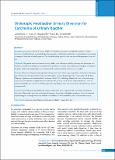Please use this identifier to cite or link to this item:
https://hdl.handle.net/20.500.14356/1940Full metadata record
| DC Field | Value | Language |
|---|---|---|
| dc.contributor.author | Lamichhane, N | - |
| dc.contributor.author | Nepal, U | - |
| dc.contributor.author | Neupane, B R | - |
| dc.contributor.author | Thakur, B K | - |
| dc.contributor.author | Shrestha, B N | - |
| dc.date.accessioned | 2023-06-02T05:42:20Z | - |
| dc.date.available | 2023-06-02T05:42:20Z | - |
| dc.date.issued | 2012 | - |
| dc.identifier.citation | LamichhaneN., NepalU., NeupaneB. R., ThakurB. K., & ShresthaB. M. (2013). Orthotopic Neobladder Urinary Diversion for Carcinoma of Urinary Bladder. Journal of Nepal Health Research Council. https://doi.org/10.33314/jnhrc.v0i0.332 | en_US |
| dc.identifier.issn | Print ISSN: 1727-5482; Online ISSN: 1999-6217 | - |
| dc.identifier.uri | http://103.69.126.140:8080/handle/20.500.14356/1940 | - |
| dc.description | Original Article | en_US |
| dc.description.abstract | Abstract Background: Invasive cancers of urinary bladder need radical cystectomy as an optimal treatment. Urinary diversions of different types are available after the procedure. Orthotopic neo-bladder reconstruction is an emerging technique of diversion in suitable patients. The aim of this study was to see the outcome of this procedure in our set up. Methods: The patient with carcinoma of urinary bladder who underwent radical cystectomy and orthotopic neo-bladder reconstruction during five year period were included in the study from department of surgical oncology in a hospital. Studer type ileal pouches were made in all the patients and their outcomes were studied. Results: There were 30 patients among which 28 were male and 2 female. Age ranged from 38-60 years with mean age of 49.6 years. Average operative time was 330 minutes. Average hospital stay was 16 days (range 14-30 days). Majority of patients were transitional cell carcinoma 26 (86.7%) in histology. Majority of cases presented in stage II (53.3%). Post-operative complications were ileus in 30%, urinary leak in 26.6% and pneumonia in 13.3% of patients. Mortality was 1 (3.3%) on 29th postoperative day. Patients were able to micturate with satisfactory stream postoperatively. Conclusions: Orthotopic neobladder has similar complication rates compared with other forms of continent diversions. This method gives less psychological trauma to the patients with higher acceptance. So we recommend transforming the technique from ileal conduits to neobladder in well-established pelvic reconstruction set ups. Keywords: carcinoma urinary bladder; orthotopic neobladder; urinary diversion. | en_US |
| dc.language.iso | en | en_US |
| dc.publisher | Nepal Health Research Council | en_US |
| dc.relation.ispartofseries | Sep-Dec, 2012;332 | - |
| dc.subject | Carcinoma urinary bladder | en_US |
| dc.subject | Orthotopic neobladder | en_US |
| dc.subject | Urinary diversion | en_US |
| dc.title | Orthotopic Neobladder Urinary Diversion for Carcinoma of Urinary Bladder | en_US |
| dc.type | Journal Article | en_US |
| local.journal.category | Original Article | - |
| Appears in Collections: | Vol. 10 No. 3 Issue 22 Sep - Dec, 2012 | |
Files in This Item:
| File | Description | Size | Format | |
|---|---|---|---|---|
| 332-Article Text-331-1-10-20130823.pdf | Fulltext Download | 154.08 kB | Adobe PDF |  View/Open |
Items in DSpace are protected by copyright, with all rights reserved, unless otherwise indicated.
